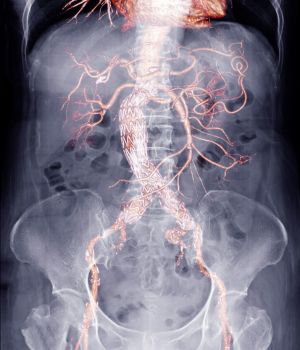Aneurysms are abnormal dilations of arteries that can occur in the aorta, peripheral arteries (legs, arms), or visceral arteries (organs). If left untreated, aneurysms can rupture, leading to life-threatening internal bleeding. Early diagnosis and intervention protect your vascular health and prevent catastrophic events.
Why Vascular Health Matters
Aneurysms often grow silently without symptoms. Risk of rupture increases with size and location. Untreated aneurysms can result in severe pain, internal bleeding, organ damage, or death. Timely detection, monitoring, and treatment are critical to prevent complications.
What is Aneurysm Management?
Aneurysm management aims to prevent rupture, restore normal blood flow, and maintain arterial integrity. Approaches include careful monitoring, medication, minimally invasive endovascular repair, or open surgical repair, depending on size, location, and patient health.
Steps of Evaluation and Treatment
- Consultation & Diagnosis: Detailed clinical evaluation, imaging (CT angiography, MRI, ultrasound), and lab tests.
- Treatment Plan: Customized based on aneurysm location, size, growth rate, and patient risk factors.
- Procedure: Endovascular repair or open surgery as indicated.
- Recovery: Outpatient or inpatient recovery, depending on procedure type.
- Follow-Up Care: Regular imaging and check-ups to monitor aneurysm stability and prevent recurrence.
Types of Aneurysms and Treatments
- Aortic Aneurysm: Abdominal or thoracic; treated with EVAR (endovascular aneurysm repair) or open repair.
- Peripheral Aneurysm: Popliteal, femoral, or other limb arteries; minimally invasive stenting or surgical repair.
- Visceral Aneurysm: Splenic, hepatic, or renal arteries; endovascular coil embolization or stent-graft placement.
When You Should Come to Us
Seek immediate evaluation if you notice:
- Sudden, severe pain in the abdomen, back, chest, or limbs
- Pulsating masses in the abdomen or extremities
- Family history of aneurysms
- Unexplained fatigue, dizziness, or low blood pressure
How the Treatment Works
- Assessment & Imaging: Map aneurysm size, location, and blood flow using advanced imaging.
- Intervention: Endovascular stents, coil embolization, or open surgical repair based on aneurysm type.
- Recovery & Monitoring: Post-procedure observation, imaging follow-up, and lifestyle guidance.
What Is Our Service Here?
- Personalized aneurysm evaluation and risk assessment.
- Advanced imaging for precise diagnosis.
- Minimally invasive endovascular procedures or open surgical repair.
- Comprehensive post-procedure monitoring and long-term care.
Management and Aftercare
- Blood pressure and cholesterol control
- Lifestyle modifications, including diet, exercise, and smoking cessation
- Regular imaging to monitor for aneurysm recurrence or growth
- Education on the warning signs of rupture or complications
Insurance & Cost Plan
- Coverage: Most medically necessary aneurysm treatments are covered by insurance.
- Verification: Costs vary by plan; call our office to confirm.
- Elective / Preventive Procedures: Cash-pay options may apply.
- Payment Options: Financing and flexible self-pay plans available.
Dos and Don’ts After Treatment
Dos:
- Take prescribed medications and follow lifestyle guidance.
- Attend all follow-up appointments.
- Maintain healthy activity levels per the physician’s advice.
Don’ts:
- Skip imaging or medications.
- Ignore new pain or pulsations.
- Engage in high-risk activities without clearance.
Is It Curable?
While the structural weakness of arteries cannot always be reversed, aneurysms can be effectively managed and repaired to prevent rupture and complications.
What Questions Should I Ask My Surgeon / Healthcare Provider?
- What type of aneurysm do I have, and what is the treatment plan?
- Is endovascular repair suitable for my aneurysm?
- What are the risks and benefits of surgery or stenting?
- How often will I need imaging follow-ups?
- What lifestyle changes are essential to prevent progression?
Expected Results
- Reduced risk of rupture and life-threatening bleeding.
- Improved blood flow and vascular stability.
- Faster recovery with minimally invasive techniques.
- Long-term monitoring for optimal vascular health.
Benefits of Our Aneurysm Program
- Expert care from the best vascular surgeon in Houston, Texas
- Advanced minimally invasive and surgical repair options
- Personalized treatment and long-term follow-up
- Prevention of rupture and improved quality of life
Why Choose Us
Our Houston, Texas clinic provides expert aneurysm care with advanced imaging, minimally invasive endovascular techniques, and personalized surgical plans. We focus on preventing rupture, restoring blood flow, and ensuring long-term vascular health.
Frequently Asked Questions (FAQ)
Is aneurysm repair risky?
Modern endovascular and surgical techniques are highly safe and effective.
How soon will I recover?
Recovery depends on the procedure type, but minimally invasive techniques offer faster healing.
Can aneurysms recur?
Regular monitoring and lifestyle management significantly reduce the risk of recurrence.
Schedule an Appointment
If you suspect an aneurysm or have risk factors, early evaluation is critical. Contact our Houston, Texas clinic today to schedule your consultation and protect your vascular health.


